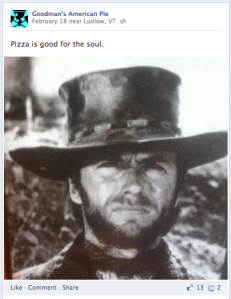Earlier this week, I came across an analysis of the top five American pizza brands in social media. True Social Metrics took a look at the Facebook activity of Pizza Hut, Domino’s, Papa John’s, Little Ceasar’s and Papa Murphy’s to evaluate the effectiveness of the brands’ social media campaigns. Here is what they came up with.

These analytics require some explanation and so I’ll give you a brief rundown.
The conversation rate refers to the number of audience comments or replies per post and provides quantitative as well as qualitative data about the audience. The amplification rate refers to the rate at which your followers take your content and share it through their network. The applause rate is the number of likes per post.
These measurements provide unique statistics that indicate what your brand is doing well and where it can improve.
Pizza Hut nailed it, with consistency cross the board and should just keep on keeping on.
Curiously, Domino’s takes the lead in the applause rate. “Liking” a post is the least engaging thing a follower can do, and so one might consider that the applause rate may not be the greatest indication of effectiveness. If the goal is to maximize audience participation, is Domino’s is posting enough engaging material?
Don’t let the graphic deceive you, Little Ceasars‘ is doing well. The brand is consistent in all three categories; the numbers are just smaller. This makes sense, with 6x less fans than Pizza Hut.
According to the study, Papa John’s‘ activity is dangerous because they have many comments but few likes or shares. What would cause this? A closer look…
Lastly, Papa Murphy’s is doing alright. It might not hurt for them, like Domino’s, to reach out to their fans by posting more engaging content.
I was totally enlightened by these social media metrics and glad to share them with you guys. I think the most important thing to take away from this analysis is that numbers mean very little if the context and meaning behind them are neglected. These metrics are a way to view your campaign comprehensively, but brands should not make the mistake of ignoring the content behind the numbers.
For more information about how to measure a brand’s social media effectiveness, I reccomend Occam’s Razor‘s “Best Social Media Metrics: Conversation, Amplification, Applause, Economic Value”.
NP 4/30









